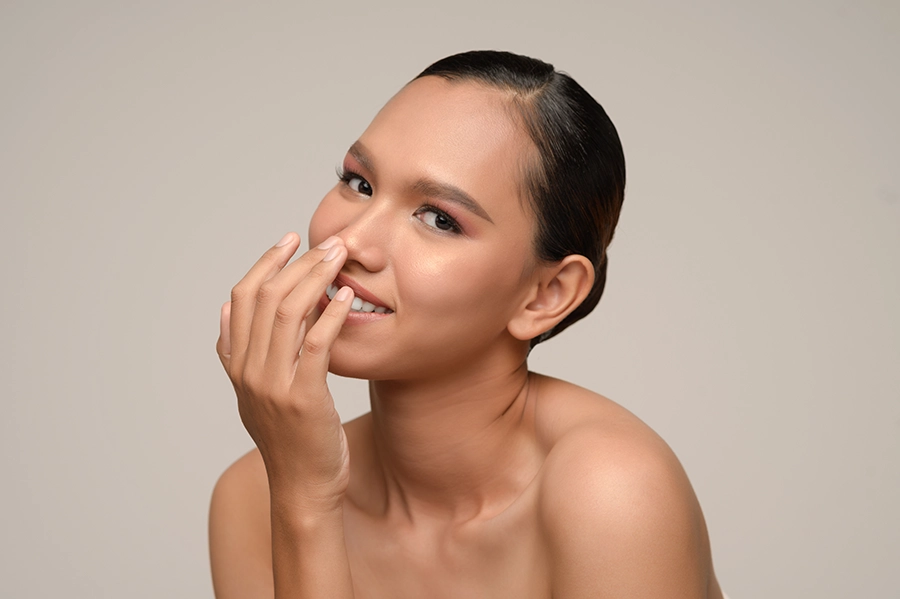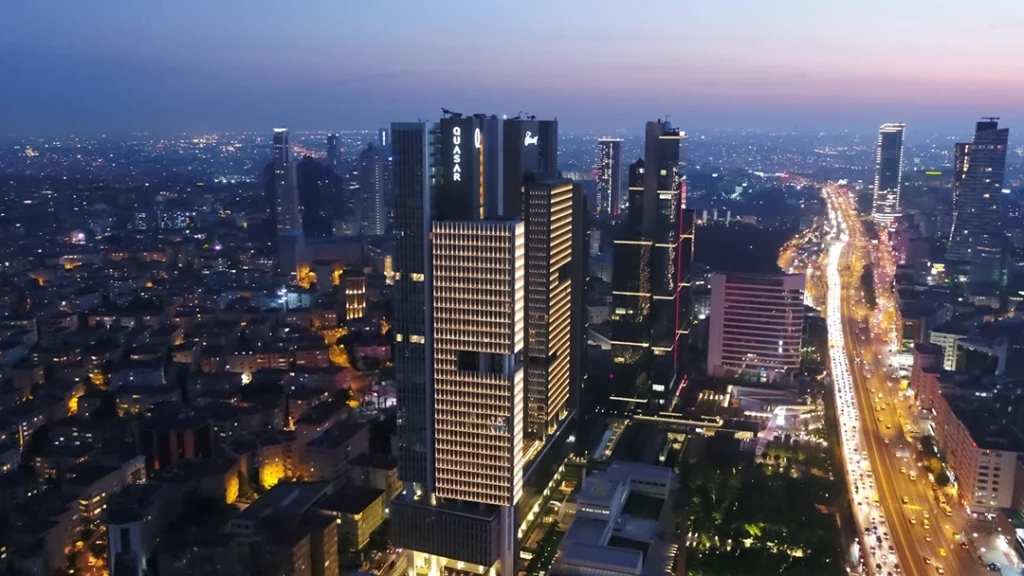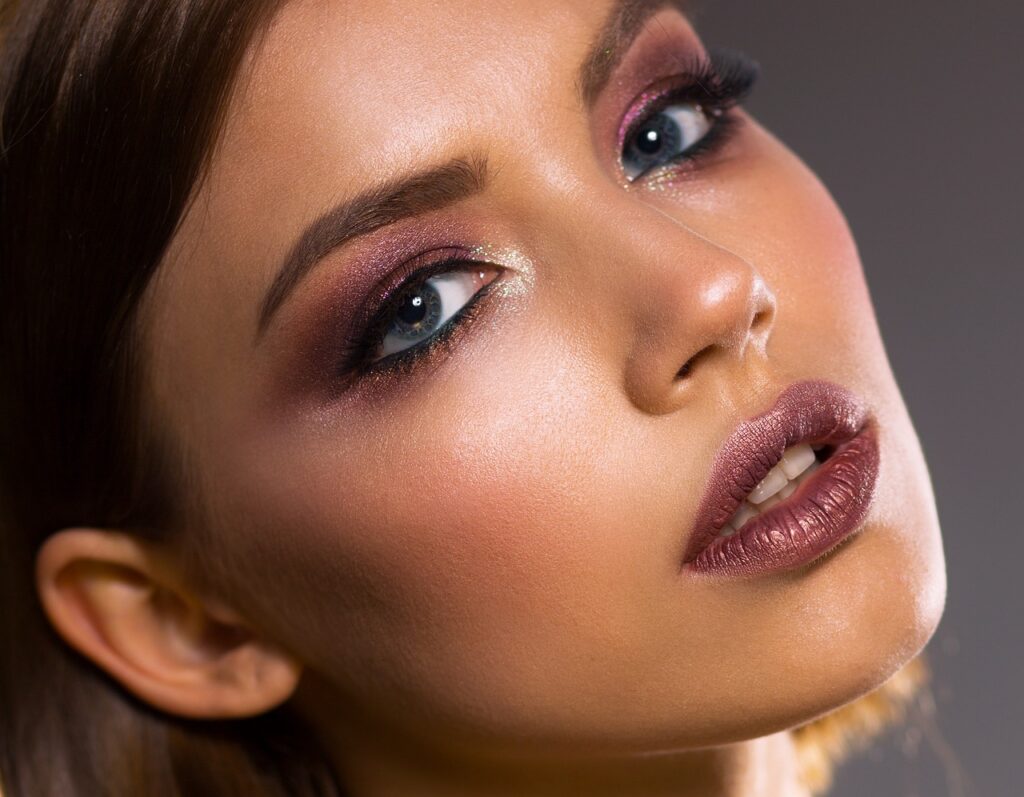Examples of changes before and after rhinoplasty, follow-up recommendations, rhinoplasty patient photos, the best surgeons in Istanbul and Turkey are discussed in this blog post.
Rhinoplasty (Nose Job) Before and After Photos
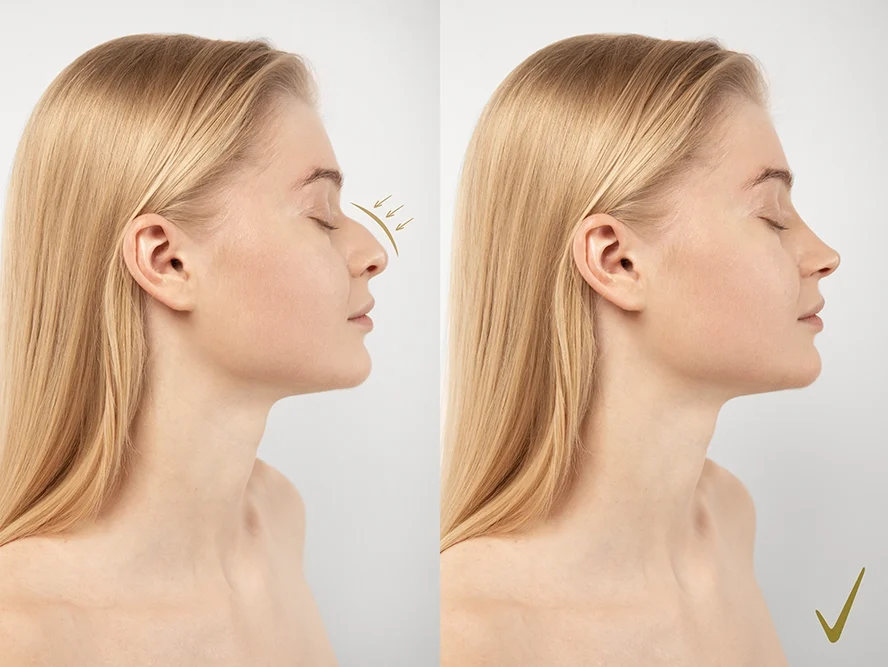
Rhinoplasty before and after realistic expectations:
The results obtained after nose surgery may not be perfect in every patient. The main reasons for this are:
– The surgery involves not only bone and cartilage tissue but also skin and subcutaneous tissue,
– Individual differences in the existing anatomical structure of the patient and the healing process,
– Factors such as skin type, thickness and healing process are individualised.
Rhinoplasty specialists usually state that 70-80% similar results can be obtained in simulation studies performed before surgery. However, this does not mean the surgery will have the same result. These before and after rhinoplasty studies performed with Photoshop-based programmes are targeting and planning. It does not mean that it will never be the same.
Why is an evaluation after rhinoplasty necessary?
The success of the surgery should be measured by the rate of positive change obtained when compared before and after surgery.
In rhinoplasty surgeries, each revision surgery performed to correct minor defects may carry certain risks and complications. Therefore, before-and-after photo or video evaluations are important to follow the patient’s postoperative change and reach realistic results. When evaluating the postoperative results, it is necessary to take into account the change and the images before the surgery.
Why are realistic rhinoplasty before and after expectations important?
Each patient experiences a different journey during the recovery process after rhinoplasty. Additional interventions may be required to perfect small details, but each intervention has its own risks. Therefore, it is the most realistic approach for patients to act with realistic expectations and evaluate the postoperative results in the long term in comparison with the previous ones.
How will be works rhinoplasty before and after process?
During the recovery process after rhinoplasty surgery, patients must know what to expect at certain stages. In an average of 5-6 days after the surgery, plasters and splints are removed or new ones are applied. At this stage, the nose can be roughly evaluated regarding its side profile, appearance at 30 degrees, tip, and symmetry. However, this process is still quite early. Therefore, the next image is quite far from the before-and-after rhinoplasty dreams.
For this reason, many surgeons prefer to support the nose by applying a second plaster and splint. Usually, this second application is removed after a week; the nose remains completely open on the 15th day or second week. At this stage, the shape of the nose begins to become largely distinct and has an overall different and aesthetic appearance. However, due to oedema still present, the nose may appear more swollen and larger when comparing pre-and postoperative photos.
When does the oedema diminished after the nose surgery?
Rhinoplasty oedema reducing period will be stp by step:
– First few weeks: The oedema decreases rapidly thanks to regular nasal massages applied by the patient. Within 1-2 months, the nose approaches its final appearance to a great extent.
– First month: During this period, the change is evaluated by taking before and after photos or videos of the patient. Positive changes become more evident in this period. Therefore, the patient starts to be satisfied with the result of nose surgery.
First 3-4 months: The oedema on the back and sides of the nose is largely reduced. However, the bones have not yet fully fused. This is the period when patients look at their noses the most and worry about some situations that may be negative. Because the oedema on both sides of the nose does not decrease in the same way, correct massage applications during this period are very effective.
– 3-6th month: The massages recommended by the surgeon help increase symmetry by applying to the side walls, back, and wings of the nose.
When does nasal tip oedema resolve?
After nasal surgery, it may take approximately 6-8 months for the micro-edema to decrease and the nasal tip to become refined.
For patients undergoing their first surgery, the most realistic assessment should be made after 6-8 months.
For revision patients, it may take 8-12 months for the nose’s shape to settle fully.
– Micro-edema process: The nose tip becomes increasingly refined and smaller for 2 years after surgery.
The fusion of the nasal bones is completed mainly during this period. Strong messages can achieve symmetry increases at the millimetre level. However, it is very important that these massages are performed with the correct technique and according to the doctor’s recommendation.
The healing process after rhinoplasty may vary depending on the patient’s anatomical structure, skin thickness, and surgical technique. Patiently following the care protocols recommended by the doctor will ensure the best results of the surgery.
Evaluation of different nose shapes before and after surgery :
Each patient’s facial and nasal anatomy is unique. Therefore, the manoeuvres and surgical techniques to be applied during nose surgery are determined individually. Likewise, the healing process may also show individual differences.
Factors affecting the healing process:
– The time for diminishing oedema in the skin and subcutaneous tissues varies from person to person. Each skin structure has advantages or disadvantages after surgery.
– Thick skin and thin skin difference is one of the most effective reasons for the desired results before and after nose surgery.
– Thin skin clearly shows even very small deformities.
– Thick skin can camouflage small irregularities by providing an advantage. However, it can be a disadvantage regarding nose reduction and refined appearance.
Subcutaneous thinning in thick-skinned rhinoplasty
If subcutaneous thinning is performed in rhinoplasty surgeries, the healing process and evaluation of the results may differ.
Subcutaneous thinning is a technique that should be applied with care. If applied incorrectly, it can lead to serious complications such as skin tissue loss (skin necrosis). The healing process may be longer in this group of patients because lymph drainage is reduced, and tissue recovery progresses more slowly.
Rhinoplasty before-after ultimately evaluations are usually performed around 6 months after the patient’s first surgery. However, this process may take 8-12 months in patients undergoing subcutaneous thinning.
How is the nose-lip angle (Rotation) evaluated after rhinoplasty?
The method used to determine the nose-lip angle in rhinoplasty surgeries can also affect the healing process:
1. In some surgical techniques, the nose-lip angle is fixed to the septum cartilage with permanent sutures during surgery. In this case, the tip of the nose remains in the same position permanently.
2. In some surgical techniques, the nose tip is positioned slightly higher during surgery. With the effect of gravity, it is expected to reach a more natural position over time.
Both methods have advantages and disadvantages. Therefore, it may take an average of 2-3 months for the nasal tip to reach the ideal level after rhinoplasty.
How long does the sitting process of nasal tip lift last?
– 2-3 months: Nasal tip lift becomes prominent and settles over time.
– 6-8 months: The shape of the nose becomes clearer, but the oedema continues to subside completely.
– In this process, small changes can still be achieved in the shape of the nose with regular massages.
It should not be forgotten that the process after nose surgery may show individual differences. While doing rhinoplasty before-and-after evaluations, the patient’s surgical technique, skin type and healing speed should be considered.
What are the effects of rhinoplasty surgeries on psychology?
The nose is an important structure located in the centre of the face and directly affects the way a person perceives himself/herself. After nose surgery, this effect can become even more pronounced. People constantly follow the change in their nose in the postoperative period and become more sensitive to its appearance.
During this period, positive or negative comments from the environment can directly affect a person’s psychology. In particular, the fact that the healing process after nose surgery may vary over time, oedema may increase in some periods or not decrease symmetrically may cause psychological difficulties in patients.
What should be done to make the postoperative psychological process healthier?
– Following the before and after changes with photos and videos helps to evaluate the healing process more objectively.
– It is important not to interrupt regular controls following the surgeon’s recommendations and to proceed in line with professional opinion.
– It is essential to know that oedema is temporary in the first months and that the shape of the nose will settle over time.
How should the rhinoplasty before and after follow-up process for patients from abroad or out of town?
The postoperative follow-up process can be carried out differently depending on the patient’s location.
– Many surgeons regularly request video recordings of patients who are followed remotely.
Taking these videos from the right angles is of great importance for the surgeon to give the most accurate directions to the patient.
Correct follow-up after rhinoplasty increases the success of the surgery and helps the patient have a more positive psychological recovery.
Why is the surgeon’s experience necessary for successfuly nose jobs?
Rhinoplasty surgeries are among the surgical procedures that need to be planned individually and require a high level of experience. The nose is located in the centre of the face and is of great importance aesthetically and functionally. Many anatomical factors such as cartilage, bone, soft tissue, skin and subcutaneous thickness should be considered during nose surgery.
This makes rhinoplasty surgeries a field that requires special expertise and experience. Therefore, it is important for people considering rhinoplasty to investigate the surgeon they choose in detail. In particular, choosing surgeons with extensive experience in rhinoplasty can greatly affect the success of the surgical results.
How can I find the right surgeon to get best before and after rhinoplasty results?
Firstly, I recommend you to follow a nose surgeon with more than one high-level experience. In this respect, the surgeon’s academic studies, curriculum vitae, before and after rhinoplasty results of the patients he operated on, and their detailed comments will give you an idea.
Here are some recommendations for you to reach the surgeon who can achive before and after rhinoplasty results that you dream of:
1. Try to learn the surgeon’s style in surgery: Every surgeon has a style, and the noses they have made are usually similar or may have many points in common. At this point, you should understand whether the surgeon’s style matches your expectations. For example, while some surgeons prefer to make noses that are more natural and not obvious that they are rhinoplasty surgery, some surgeons may prefer to make noses that are more flashy and showy, tip up, more curved, less natural, and more aesthetic. You can understand all these in detail by comparing the surgeon’s previous and subsequent rhinoplasty results, preferably videos with before and after results.
2. Focus on the results of patients who look like you: It is essential that the nose and facial structures of the people whose results you will compare before and after rhinoplasty are similar to you. Finding patients similar to your general face shape, skin thickness, and general facial ratios and focusing on the results the surgeon will achieve in these patients can help you have a more realistic idea. For example, when you look at any patient’s before and after results, it may be quite different from your current nose. If the person you are looking at has an idea about your own before and possibly after results if there is only a slight nasal dorsal arch and a few degrees of drooping at the tip, it may be easy for any surgeon to transform them close to perfect. However, your general facial proportions, skin thickness, and other underlying anatomical conditions may not be the same as that person. Therefore, the same before and after rhinoplasty results may not be realized in you. In this respect, it is vital to be completely objective and follow patients similar to you.
3. Evaluate surgeons patient photos and videos before and after rhinoplasty: If the surgeon you are considering has patient stories before and after past rhinoplasty surgery, you can access them. This may be a photograph, video, or evaluation of the person about the surgery performed in any media. These will also give you a great idea. In this respect, I recommend you follow various patient stories.
4. You should objectively evaluate patient comments before and after rhinoplasty: Nowadays, as we all know, much information is circulating online. On many platforms, anyone who wishes can write comments about people as they want. These comments can sometimes be marketing comments written by institutions and businesses to praise them, that is, to increase the number of stars, and sometimes, they can be blackmailing articles aimed at blackening any surgeon or clinic individuals because rhinoplasty surgery is a cosmetic surgery. And any surgeon can not guarantee a 100% perfect result to any patient after surgery. When it comes to the success of this surgery, the rate of “positive change before and after rhinoplasty” is essential. Therefore, their satisfaction rates differ even if people have similar success rates. Consequently, consider these situations when evaluating the patient stories, photos, or comments you will look at. When we do a general mathematical calculation, a surgeon may intensively and generally obtain results before and after rhinoplasty surgery with high success. However, when he operates on a large number of patients, it is possible that a certain proportion of patients are not happy enough, dissatisfied, or have thoughts that are not positive enough for that surgeon for various reasons after surgery. Suppose you are going to follow a surgeon. In that case, you should not focus only on positive or negative comments but also on the number of comments and the positivity rates of the comments in that number. Examining the comments will help you understand whether those people are real people and whether they share a photo or video about their results.
In light of these, first of all, ask all the questions in your head to the surgeon who will perform your surgery with online consultations and taking into account the surgeon’s ideas about the results that can be achieved and preparing yourself accordingly and preparing your expectations. Therefore, it can have significant benefits in being psychologically ready for this process.
What are the possible consequences of choosing the wrong surgeon?
– Finding the right surgeon during the first surgery is a critical step.
– In some nasal structures, undesirable results may occur due to inadequate planning.
– Even in cases requiring revision, achieving a successful revision surgery result may be difficult due to the mistakes made during the first surgery.
For this reason, it is important to choose the right surgeon and plan the surgery meticulously.
Why is the hospital where the surgeon works and the team’s experience critical for better results?
Another important point is the hospital’s and team’s experience and equipment where the surgeon will perform the surgery. In sensitive operations such as rhinoplasty:
– The experience of the anaesthesia team,
– Operating theatre equipment and hygiene conditions,
– Factors such as the quality of the postoperative care process are extremely important.
Researching a surgeon will help you make a healthy decision to evaluate the hospital and team where he performs his operations rather than just examining his social media accounts.
For a successful recovery process after rhinoplasty, choosing the right surgeon, having a reliable hospital environment, and performing operations with an expert team will provide much more desired results.
How are digital planning and simulation studies used in rhinoplasty surgeries?
In rhinoplasty surgeries, many surgeons evaluate the existing nasal structure by taking patient photographs before surgery and discussing the patient’s expectations in detail. The primary purpose of this process is to understand what the patient expects from rhinoplasty and to make a more informed decision about possible outcomes.
Digital simulation studies performed at this stage give the patient an idea about the possible nose shape after surgery. The most crucial advantage of simulation is that it helps the patient to see in advance which interventions will be more compatible with their face.
However, simulation studies are not a visual show but a process of creating a realistic consensus between the patient and the surgeon. No surgeon can guarantee that the image shown in the simulation will be 100% identical.
How accurately do digital simulations predict the results after the nose surgery?
Experienced surgeons predict that postoperative results can be similar to the simulation in approximately 70-80% of cases. This rate may vary depending on factors such as the surgeon’s experience, the patient’s skin structure and nasal anatomy. However, it is not possible to have the same result.
It is important that the patient clearly expresses his/her expectations during this process. While some patients want a more pronounced curve, others may prefer a flatter and more natural nasal structure.
While some patients want the tip of the nose to be raised more, others may prefer a more natural and less raised nose.
– These personal preferences should be discussed with the surgeon before surgery.
Digital imaging works effects to the surgery planning and patient satisfaction:
Clarifying all these details, both in the clinical interview and on the day of surgery, is an important factor that directly affects the success of rhinoplasty.
In summary:
I will try to summarise some of the recommendations that will help you achieve the rhinoplasty before and after result you dream of:
1. To get the best before and after rhinoplasty results you want, I recommend you see the changes before and after through the photos of patients who are more similar to you, preferably on video.
2. You should find a surgeon who is experienced and interested in these surgeries, especially rhinoplasty ones.
3. You should have detailed information about the natural and possible results of the surgery in a realistic way.
4. You should accustom yourself to the fact that rhinoplasty surgery is a surgery of patience and that the results that will make you happy will appear after a few months.
5. You should remember that after each rhinoplasty surgery, there may not be the desired pre-post results, and some situations may require you to undergo surgery again, which we call revision rhinoplasty.
6. Besides the contributions that this surgery will bring you, you should prepare yourself psychologically for your possible future nose by considering its advantages and disadvantages in detail and in the light of realistic data.
Briefly; In light of all these, you can achieve your dream nose when you find and choose the right surgeon with realistic and correct expectations for rhinoplasty surgery. Correct planning with realistic expectations and surgeon-patient cooperation ensures that the recovery process after rhinoplasty is more comfortable and the satisfaction with the results increases.
 Nose Job is a team effort
Nose Job is a team effort
Some Rhinoplasty Before and After Results:





























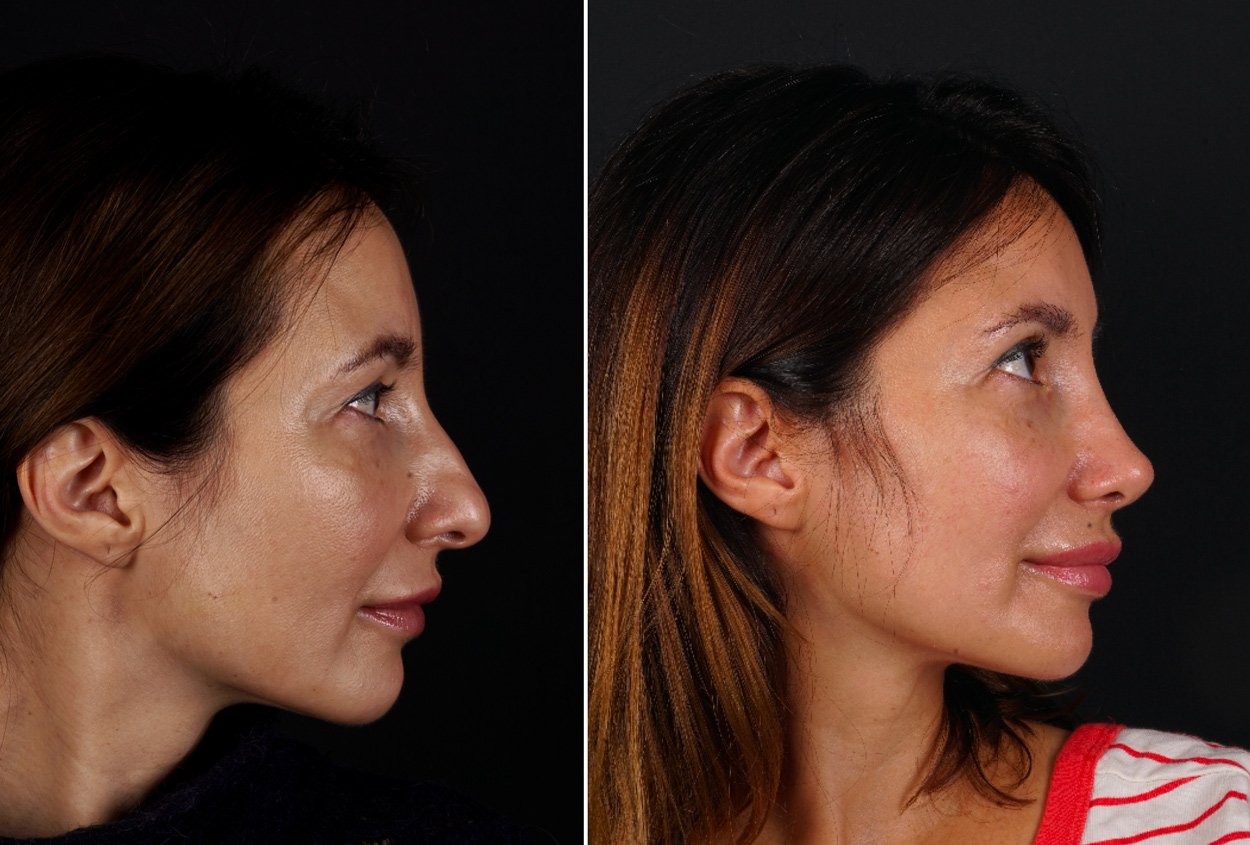
Before and After Rhinoplasty Results
Rhinoplasty Before ad After FAQ:
What should be the goals before and after rhinoplasty?
Rhinoplasty is an operation that aims to change the skeleton of the nose for aesthetic and functional reasons. One of the main aim of this surgery is to achieve a more harmonious and aesthetic nasal appearance before and after surgery. In addition, rhinoplasty can also be applied to eliminate breathing problems, called functional rhinoplasty.
What should I expect when evaluated before and after rhinoplasty surgery?
1. First Operation Rhinoplasty: It is the standard procedure performed for patients undergoing rhinoplasty for the first time.
2. Revision Rhinoplasty: It is the second or more surgeries performed to improve the results of a previous rhinoplasty surgery.
3. Ethnic Rhinoplasty: A particular type of rhinoplasty is performed by considering the nasal features specific to people from different ethnic groups.
4. Functional Rhinoplasty: In addition to aesthetic improvements, it is a procedure that aims to facilitate breathing.
5. Ultrasonic Rhinoplasty: It is a modern technique that uses ultrasonic devices while shaping the nasal bones.
Does open or closed surgery affect the results of rhinoplasty?
Rhinoplasty surgeries are usually performed using “open” or “closed” methods. Open versus closed ( endonasal) approaches refer to the way the surgeon accesses the tissues at the tip and back of the nose. While open rhinoplasty is performed by opening the entire nose with a cut made through the skin between the two nostrils, closed rhinoplasty can be performed through the nostrils through an incision that is not visible from the outside.
For those considering surgery, it is crucial to evaluate the possible results and the operation process in detail. Simulation studies on your photographs showing your possible results before and after and the experiences of patients who have undergone similar surgery can help you decide.
What expectations should I have after the surgery compared to before?
1. This is corrected if the nose has a symmetry disorder. In other words, if there is an axis curvature, a symmetry problem between the wings and holes of the nose, this can be made more harmonious and acceptable with both sides of the face.
2. This is removed if a bump and excess bone are on the back of the nose. Therefore, a more beautiful facial appearance can be achieved after the nasal ridge is removed.
3. Nasal tip refining (refining and revealing) can make the nose tip more prominent. With this procedure, when the before and after results are compared, better light and shadows are captured by regulating the transitions between the nose tip and its upper and lower and right and left parts. This provides a more aesthetic appearance in the facial appearance of the person.
4. Breathing disorders can be corrected. In this way, the person can get much better oxygen from both nostrils. Moreover, this situation can significantly contribute to snoring and sleep quality compared to before and after rhinoplasty.
5. The harmony of the nose with other facial structures is increased. A more symmetrical image of the person with both sides of the face can be achieved, as well as the harmony of the nose in the center of the face and a more natural, aesthetic, and sympathetic appearance with other facial structures.
6. With the emergence of all these positive changes after the surgery, the person’s self-confidence increases and contributes to their psychology more positively. In other words, it is possible for the person to have a more positive and self-confident psychology when compared to before and after rhinoplasty surgery.
7. Social relations become more positive. When compared before and after rhinoplasty results, the person can become more social, positive, and successful.
When these significant changes are compared before and after rhinoplasty, results that will make the person much happier can be achieved. In the statistics, when asked about rhinoplasty surgery and patient satisfaction before and after rhinoplasty surgery, an average of 97% of people stated that they were satisfied with this surgery. This provides essential data about the changes before and after rhinoplasty surgeries.
What are the risks and complications of rhinoplasty surgery?
These risks may include the following:
1. General Anaesthesia Risks: Although modern anesthetic techniques are pretty safe, some rare risks associated with general anesthesia are present in rhinoplasty surgery, as in any surgery.
2. Oedema and Bruising: Edema and bruising may occur more than typically during postoperative healing.
3. Pain: Mild to moderate pain may occur after surgery, but this can usually be controlled with standard painkillers.
4. Nasal Congestion and Sleep Problems: Sleep problems due to nasal congestion may occur in the first few days after surgery.
5. Temporary Decrease in Daily Activities: There may be a slight decrease in personal daily routines after surgery, but most patients can return to normal activities within a few days.
6. It is an operation that requires patience and partially long recovery: After the first rhinoplasty surgery, it is necessary to wait for the shape of the nose to settle ultimately within 4-6 months to evaluate the change before and after. Sometimes, the result may only not meet the patient’s expectations. This may require a revision surgery depending on the person’s level of satisfaction.
7. Revision Rates: Each surgeon has different revision rates, and situations requiring revision may also depend on some natural healing factors beyond the surgeon’s experience or the person’s underlying anatomy.
As with any surgical procedure, rhinoplasty requires careful evaluation and selection of the right surgeon. It is important to talk to your surgeon about possible risks and complications before surgery and have realistic expectations.
What can change between before and after the succesful nose surgery?
Rhinoplasty surgeries are operations that require patience and take several months for recovery. During this period, it is expected that the oedema will decrease and your nasal breathing functions will increase. During the 4-6 months after the surgery, the appearance of your nose will make you happier, as well as the realisation of your expectation of better breathing will mean that you have had a successful nose job surgery.
Any Question?
We will be grateful to answer all your questions on Video Conference meeting
















